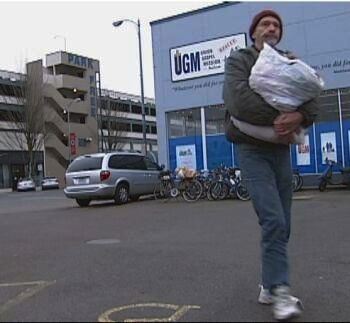
Publisher:
Bonnie King
CONTACT:
Newsroom@Salem-news.com
Advertising:
Adsales@Salem-news.com

~Truth~
~Justice~
~Peace~
TJP
Jun-14-2010 15:17

 TweetFollow @OregonNews
TweetFollow @OregonNews
SNAP, TANF Assistance to Oregon Families Continues at Record Levels
Salem-News.comBenefits are determined on a sliding scale, based on household income, and are distributed through the Oregon Trail Card that is used like a debit card to purchase food.
 Homeless man leaving the mission in Salem. KATU/Salem-News.com photo by Tim King |
(SALEM, Ore.) - More Oregonians than ever before continue to count on public services to help their families get through economic tough times. Demand for Supplemental Nutrition Assistance Program benefits (formerly food stamps) and Temporary Assistance for Needy Families (TANF) increased again last month, and the trend is expected to continue into next year.
In May, a total of 706,653 Oregonians received SNAP benefits, an increase of 17 percent from one year ago and 46 percent since the beginning of the recession in July 2008, when Oregon's unemployment rate was just above 6 percent. Last month, a total of 26,885 families received TANF — up 5 percent from a year ago and 35 percent from July 2008; this program is available only for very low-income Oregon families.
SNAP benefits provide an important bridge for people who are unemployed or underemployed and earn too little to meet their basic nutrition needs. TANF helps families pay for shelter and other necessities that parents would not be able to otherwise afford. It also provides case management services for families struggling due to unemployment, underemployment or incapacitation of a primary wage earner.
In order to keep up with the increased demand, DHS has transformed its intake process to reduce wait times and eliminate backlogs. Because of our streamlining efforts, Oregonians receive their SNAP benefits an average of nine days sooner than they did before – and in most places across the state, it is same-day service.
There are 160 DHS locations across the state where Oregonians can apply for SNAP, TANF and other benefits for which they may be eligible. Many state and federal programs have online applications: Go to oregon.gov/DHS.
Background
To be eligible for SNAP benefits, families must earn less than 185 percent of the federal poverty level, along with other factors. For a family of four, the income limit is less than $3,400 per month. The maximum benefit for a household of four totals $668 per month. The overall average SNAP benefit per household is approximately $250 per month. Approximately three-fourths of all SNAP households have some form of income, which results in the actual benefit level received being reduced from the maximum.
Benefits are determined on a sliding scale, based on household income, and are distributed through the Oregon Trail Card that is used like a debit card to purchase food. SNAP benefits can be used to purchase foods for the household to eat, such as breads and cereals; fruits and vegetables; meats, fish and poultry; and dairy products. SNAP benefits are intended to act as a supplement to a family's overall food budget, not to cover it entirely. In many households with little or no income, it can be the primary means to meet the family's nutritional needs.
To be eligible for TANF, parents with children must earn less than the total monthly income limit. For a two-parent family with two children, that maximum is $795, along with an asset limit of $2,500 (not including the family home, or the first $10,000 value of family vehicles).
The maximum benefit for the family of four, with no other income, is a total of $647 per month. TANF provides temporary assistance and case management services for families struggling due to unemployment, underemployment or incapacitation of a primary wage earner.
TANF and TANF-related programs also provide employment and training services, child care while looking for work or other alternatives, assistance seeking Social Security Income or Social Security Disability Income, and help to flee or stay free from domestic violence.
To learn more visit: oregon.gov/DHS/news/2010news/2010-0614b.pdf
Source: State of Oregon news release
Articles for June 13, 2010 | Articles for June 14, 2010 | Articles for June 15, 2010
Quick Links
DINING
Willamette UniversityGoudy Commons Cafe
Dine on the Queen
Willamette Queen Sternwheeler
MUST SEE SALEM
Oregon Capitol ToursCapitol History Gateway
Willamette River Ride
Willamette Queen Sternwheeler
Historic Home Tours:
Deepwood Museum
The Bush House
Gaiety Hollow Garden
AUCTIONS - APPRAISALS
Auction Masters & AppraisalsCONSTRUCTION SERVICES
Roofing and ContractingSheridan, Ore.
ONLINE SHOPPING
Special Occasion DressesAdvertise with Salem-News
Contact:AdSales@Salem-News.com

googlec507860f6901db00.html



Terms of Service | Privacy Policy
All comments and messages are approved by people and self promotional links or unacceptable comments are denied.
Vic June 15, 2010 8:14 am (Pacific time)
Well said, Colli !
Colli June 14, 2010 4:42 pm (Pacific time)
I would very much like to believe that this will turn-around in the near future (as the government says it is doing now), but I'm just not quite naive enough to buy into that pipe-dream. If Congress does not do something to (1) stop jobs from leaving the country, (2) bring jobs that have left the country back, and (3) create new public sector jobs, our children won't see the end of this! I believe all of this came about because our politicians have been too busy playing politics and fattening their own bank accounts when they should have been watching our backs. God bless us all because we are likely to need it.
Editor: There is a comment I agree with.
[Return to Top]©2025 Salem-News.com. All opinions expressed in this article are those of the author and do not necessarily reflect those of Salem-News.com.